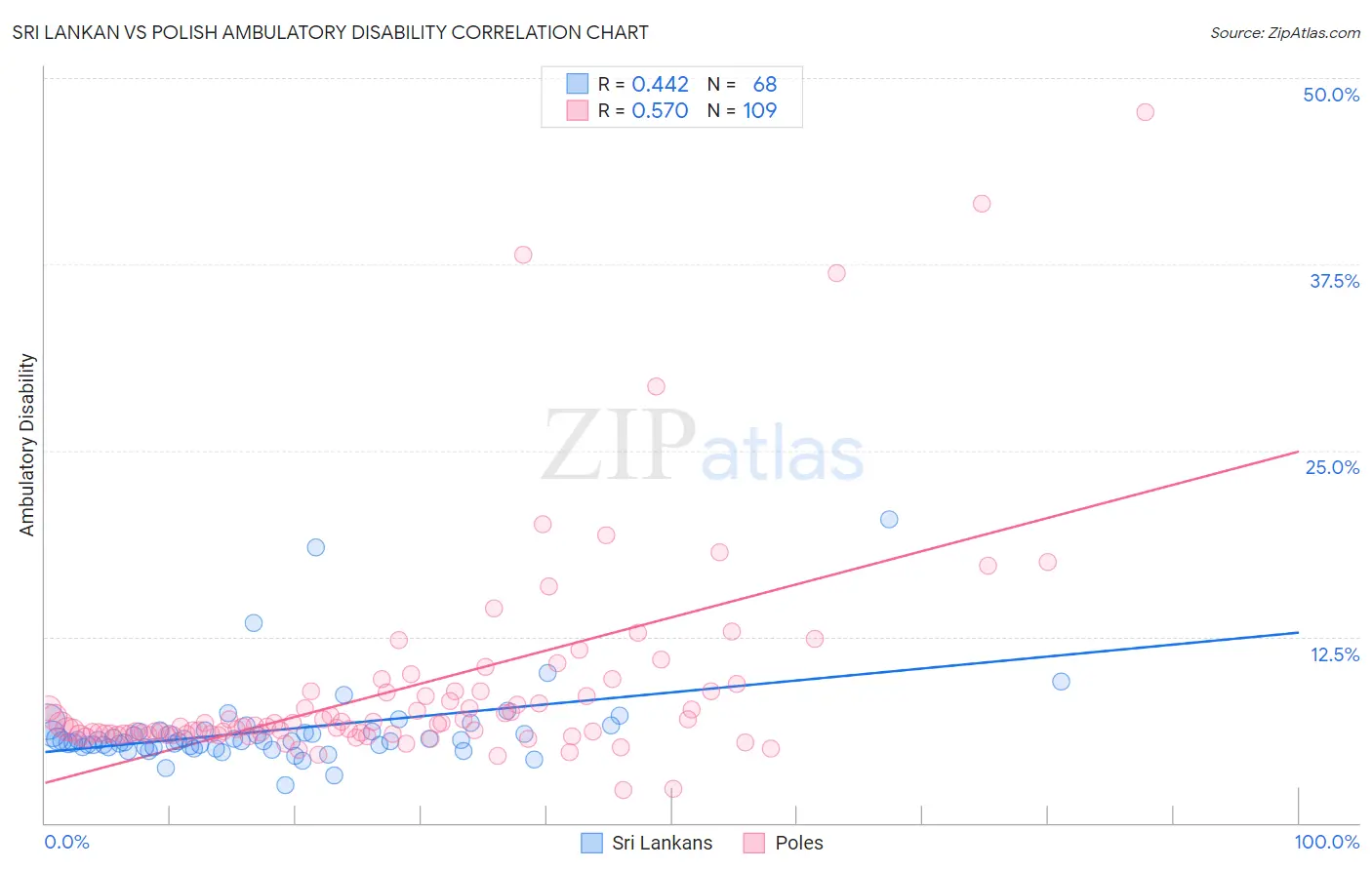Sri Lankan vs Polish Ambulatory Disability
COMPARE
Sri Lankan
Polish
Ambulatory Disability
Ambulatory Disability Comparison
Sri Lankans
Poles
5.7%
AMBULATORY DISABILITY
99.6/ 100
METRIC RATING
68th/ 347
METRIC RANK
6.2%
AMBULATORY DISABILITY
26.3/ 100
METRIC RATING
197th/ 347
METRIC RANK
Sri Lankan vs Polish Ambulatory Disability Correlation Chart
The statistical analysis conducted on geographies consisting of 440,321,822 people shows a moderate positive correlation between the proportion of Sri Lankans and percentage of population with ambulatory disability in the United States with a correlation coefficient (R) of 0.442 and weighted average of 5.7%. Similarly, the statistical analysis conducted on geographies consisting of 560,051,234 people shows a substantial positive correlation between the proportion of Poles and percentage of population with ambulatory disability in the United States with a correlation coefficient (R) of 0.570 and weighted average of 6.2%, a difference of 9.5%.

Ambulatory Disability Correlation Summary
| Measurement | Sri Lankan | Polish |
| Minimum | 2.6% | 2.2% |
| Maximum | 20.4% | 47.7% |
| Range | 17.8% | 45.5% |
| Mean | 6.2% | 9.1% |
| Median | 5.5% | 6.6% |
| Interquartile 25% (IQ1) | 5.1% | 6.0% |
| Interquartile 75% (IQ3) | 6.1% | 8.8% |
| Interquartile Range (IQR) | 1.0% | 2.8% |
| Standard Deviation (Sample) | 2.8% | 7.4% |
| Standard Deviation (Population) | 2.8% | 7.3% |
Similar Demographics by Ambulatory Disability
Demographics Similar to Sri Lankans by Ambulatory Disability
In terms of ambulatory disability, the demographic groups most similar to Sri Lankans are Immigrants from Uganda (5.7%, a difference of 0.030%), Israeli (5.7%, a difference of 0.040%), Immigrants from Switzerland (5.7%, a difference of 0.13%), Laotian (5.7%, a difference of 0.16%), and Immigrants from France (5.6%, a difference of 0.29%).
| Demographics | Rating | Rank | Ambulatory Disability |
| Immigrants | Belgium | 99.7 /100 | #61 | Exceptional 5.6% |
| Immigrants | Spain | 99.7 /100 | #62 | Exceptional 5.6% |
| Immigrants | France | 99.7 /100 | #63 | Exceptional 5.6% |
| Laotians | 99.7 /100 | #64 | Exceptional 5.7% |
| Immigrants | Switzerland | 99.7 /100 | #65 | Exceptional 5.7% |
| Israelis | 99.6 /100 | #66 | Exceptional 5.7% |
| Immigrants | Uganda | 99.6 /100 | #67 | Exceptional 5.7% |
| Sri Lankans | 99.6 /100 | #68 | Exceptional 5.7% |
| Peruvians | 99.5 /100 | #69 | Exceptional 5.7% |
| Sierra Leoneans | 99.4 /100 | #70 | Exceptional 5.7% |
| Immigrants | Peru | 99.4 /100 | #71 | Exceptional 5.7% |
| Brazilians | 99.4 /100 | #72 | Exceptional 5.7% |
| Immigrants | Northern Africa | 99.4 /100 | #73 | Exceptional 5.7% |
| Immigrants | Cameroon | 99.4 /100 | #74 | Exceptional 5.7% |
| Immigrants | South Africa | 99.3 /100 | #75 | Exceptional 5.7% |
Demographics Similar to Poles by Ambulatory Disability
In terms of ambulatory disability, the demographic groups most similar to Poles are Malaysian (6.2%, a difference of 0.12%), Immigrants from Bangladesh (6.2%, a difference of 0.12%), Belgian (6.2%, a difference of 0.15%), Alaska Native (6.2%, a difference of 0.23%), and Guatemalan (6.2%, a difference of 0.24%).
| Demographics | Rating | Rank | Ambulatory Disability |
| Immigrants | Western Africa | 33.4 /100 | #190 | Fair 6.2% |
| Immigrants | Guatemala | 31.9 /100 | #191 | Fair 6.2% |
| Immigrants | Western Europe | 31.6 /100 | #192 | Fair 6.2% |
| Guatemalans | 30.0 /100 | #193 | Fair 6.2% |
| Alaska Natives | 29.8 /100 | #194 | Fair 6.2% |
| Belgians | 28.6 /100 | #195 | Fair 6.2% |
| Malaysians | 28.2 /100 | #196 | Fair 6.2% |
| Poles | 26.3 /100 | #197 | Fair 6.2% |
| Immigrants | Bangladesh | 24.6 /100 | #198 | Fair 6.2% |
| Italians | 22.6 /100 | #199 | Fair 6.2% |
| Immigrants | Cambodia | 21.5 /100 | #200 | Fair 6.2% |
| Immigrants | Central America | 20.1 /100 | #201 | Fair 6.2% |
| Albanians | 19.7 /100 | #202 | Poor 6.2% |
| Immigrants | Ukraine | 18.4 /100 | #203 | Poor 6.2% |
| Immigrants | Congo | 18.2 /100 | #204 | Poor 6.2% |